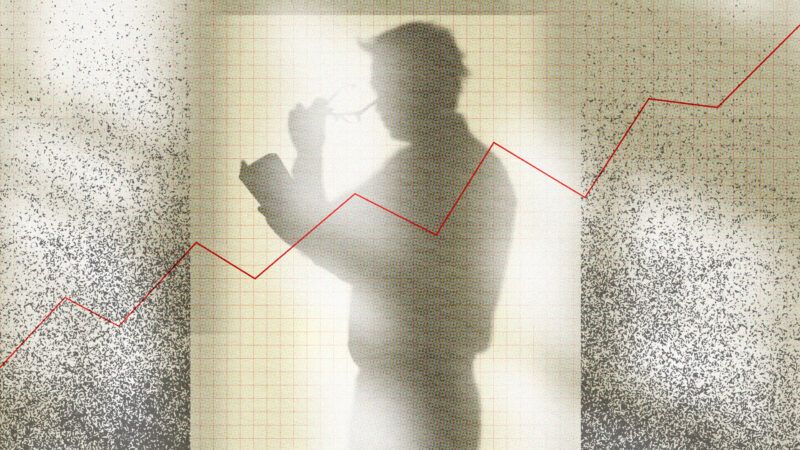Do U.S. Public Schools Really Need 77,000 More Counselors?
Schools were already staffed at record levels even before COVID-19, when enrollment fell by nearly 1.3 million students.

Public schools have a mental health crisis and only thousands of new support staff can save them. That's the narrative being pushed nationwide at a time when enrollment has crashed by nearly 1.3 million students and $190 billion in federal K-12 COVID-19 relief aid is set to expire later this year.
"It would take 77,000 more school counselors, 63,000 more school psychologists and probably tens of thousands of school social workers to reach levels recommended by professional groups before the pandemic hit," reports The Washington Post.
Now legislators in states such as Minnesota, New York, and Virginia are introducing bills aimed at getting schools closer to meeting the 250-to-1 student-to-counselor ratio recommended by the American School Counselor Association (ASCA). "We want our children to live in a state where they know they'll be able to access the mental health services they need," says Minnesota State Rep. Kaela Berg (D–Burnsville). According to ASCA, school counselor duties range from helping students manage emotions to planning for postsecondary options, but they don't help with long-term psychological disorders.
Public schools were slow to open during the pandemic and students' mental health deteriorated as a result. But even before COVID-19, schools were staffed at record levels, and policymakers have good reason to be skeptical of ASCA's guidance.
Between 2002 and 2020, public school staff grew by 13.2 percent nationwide while student enrollment increased by just 6.6%, according to a new report published by Reason Foundation. In many states—including New Hampshire, Illinois, and New York—public schools maintained or increased staffing levels despite large enrollment losses. For example, Connecticut lost 8.2 percent of its students but public school staff shot up by 14.1 percent.
But the bulk of new hires weren't teachers, which saw a 6.6-percent increase nationwide. Instead, non-teachers fueled the growth, increasing by 20 percent. For every five new students, about one non-teacher was added to public school payrolls. While a rise in central-office bureaucrats contributed to this trend, school-level personnel such as guidance counselors (up 19.5 percent), instructional aides (up 30.9 percent), and student support staff such as health and social services personnel (up 113.5 percent) were a significant driver.
One reason is that groups such as ASCA, National Association of School Psychologists (NASP), and National Association of Social Workers (NASW) all recommend staffing ratios that are used to sound alarm bells to state legislators about public school resources. While it's unclear how NASP (500-to-1) and NASW (250-to-1 or 50-to-1 for high-need schools) derived their ratios, ASCA's figure (250-to-1) doesn't hold up to the slightest amount of scrutiny.
According to ASCA, it stems from 1955 when researcher Kenneth B. Hoyt "concluded that school counselors should have no more than 400 pupils in their caseload." They adjusted Hoyt's ratio down to its current level in 1965 "as the role of the school counselor became clarified further."
But this figure was called out by a Harvard graduate student for having no empirical basis at all, despite being cited "in almost every piece that you read about school counselors." It turns out, Hoyt's original number was just a back-of-the-envelope calculation he did in a short column, which walks through some basic assumptions about what counseling might look like. At the end, Hoyt even warned against using his example to set policy:
This article has presented one person's point of view regarding the counseling load of the high school counselor. It is not represented as the answer for any particular school system nor as a generalized answer for any combination of the school system. We would not expect to find total agreement on the part of either experts or non-experts on all of the assumptions involved in the point of view presented here.
Notice that Hoyt's article was aimed at high school counselors specifically. This is important because ASCA's ratio lumps together school counselors at all levels (elementary, middle school, and high school). The national average reported by ASCA (385-to-1) exceeds its recommendation, but only because it's inflated by schools serving lower grade levels. When high schools are isolated, the national average falls to an estimated 232-to-1 ratio—well below ASCA's recommendation.
The real problem isn't that there aren't enough school counselors, but that many states already have laws on the books advancing ASCA's flawed recommendation. Then there's the question of mission creep and whether public schools should be delivering mental health services at all. Regardless, public schools have more staff than ever and with enrollment projected to continue declining for years to come, the last thing they need is 77,000 more counselors. Using a baseless metric to further this aim only undermines ASCA's credibility and those pushing their narrative.
Show Comments (45)